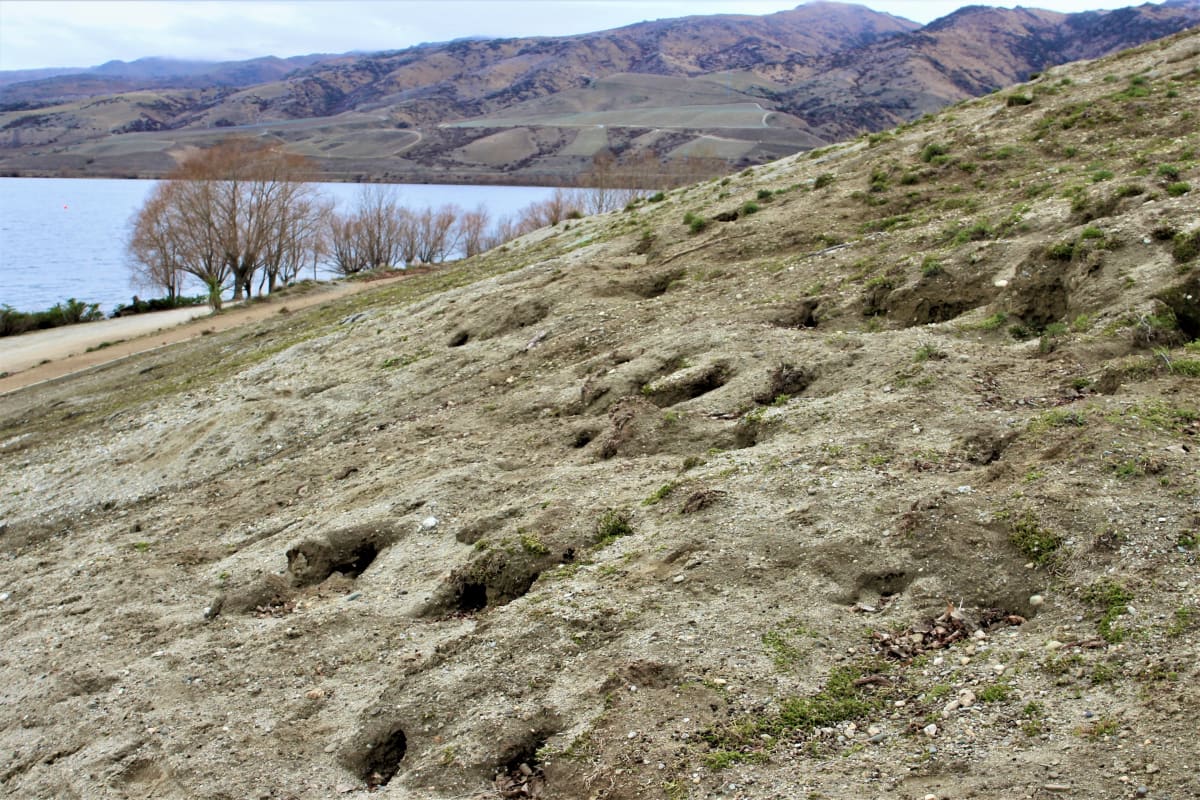
A government agency has been instructed to crack down on an out-of-control rabbit population decimating lakeside land
Government-managed land in Central Otago with an “exploding” uncontrolled rabbit population is finally getting attention after the Otago Regional Council stepped in.
Toitū Te Whenua Land Information New Zealand (LINZ) has confirmed the council inspected land it manages near Cromwell and Lake Dunstan and found it has “unacceptable levels” of rabbits.
The agency, along with a number of land-holders, has received a council “request for work” letter as part of a reinvigorated effort to push back the tide of rabbits decimating lifestyle blocks, farms and crown land.
The letters were preceded by inspections in a ramped-up monitoring programme prompted by heightened public awareness and the adoption of the council’s new regional pest-management plan.
Last year, Newsroom visited the Lake Dunstan area with a professional pest controller. Severe rabbit damage was evident, rabbits were seen in large numbers and owners of properties enclosed by rabbit-proof fences were struggling to keep the pests out. A year later, no control work has been done and new hot spots of damage are evident around the lake edges close to Cromwell township.

Sonya Wikitera, LINZ’s head of crown property, says the agency undertakes pest-control work on its land when approached by neighbours or directed by regional authorities.
“We have not carried out rabbit control around Lake Dunstan in recent times. We prioritise and allocate funding to manage pests including rabbits on LINZ-managed lands throughout the country according to requests from councils that are responsible for monitoring pest impacts and in response to information from adjacent landowners and managers.”
She says controlled areas will be monitored after the work is completed and the agency will then decide whether it will continue.
In June, LINZ issued a media statement saying rabbit control was getting under way in the Lake Dunstan area to address “exploding rabbit numbers”.
Heat-seeking shooters
It advised night shooting would take place along the Kawarau arm of Lake Dunstan using thermal-imaging equipment.
“Targeted fumigation of rabbit burrows using Magtoxin will be used to control very high rabbit numbers on the foreshore from the McNulty Inlet to Dead Mans Point area of Lake Dunstan.”

In the statement, Wikitera said uncontrolled rabbits are a serious environmental pest.
“Rabbits eat their way through native vegetation and agricultural land, turning farmland into bare, pitted ground where only weeds survive, and cost millions in lost production and control. Reducing rabbit numbers will help the survival of native plants, protect plant restoration and reduce erosion.”
She told Newsroom this week that LINZ spends about $100,000 a year on biosecurity control work in Otago.
“Most LINZ-managed land is long and narrow, including marginal strips along riverbeds and lakebeds. For this reason, wherever possible, we co-ordinate work with adjacent landowners and managers for best results.”
Rabbits part of the landscape
Meanwhile, the Mokihi Reforestation Trust says the cost of protecting plantings from rabbits at its sites on LINZ-managed land is the same, if not more, than the cost of the plants themselves.
The group, which has charitable status, aims to restore pockets of indigenous vegetation in and around Cromwell and Lake Dunstan. It has established three main sites, putting over 5000 plants in the ground and clocking up 1000 volunteer hours a year. Each plant needs the protection of sturdy wire netting to survive.
Trustee Greg Lind says it’s a high cost but dealing with the pest is an accepted part of doing business in Central Otago.
The extra workload was also “quite considerable”, but the group has no beef with LINZ over the lack of control work.
“We just live with it. It’s an ever-present problem. It’s not a factor that LINZ is necessarily responsible for it. There are plenty of rabbits in Central Otago that would invade the land even if LINZ did rabbit control.”
A bright spot in the battle is the appearance of skinks inside rabbit-netted cages to avoid being eaten by cats.
Council offensive continues
The regional council’s rabbit offensive was kicked into gear under former pest boss Andrea Howard last year, with the new plan’s directives being meted out evenly to both private and public landholders.
Howard left the role earlier this year, handing over to Libby Caldwell, the acting manager for environmental implementation.
Caldwell says 426 “request for work” letters for both rabbit and plant pest infestations have recently been issued. Recipients have included LINZ, the Department of Conservation, Waka Kotahi NZ Transport Agency, territorial authorities and private landowners.

Eighteen parties are being followed up with “notices of direction”, which are formal actions demanding work be done.
She said two directives had earlier been issued in South Otago, 15 others were being processed in Queenstown, Cromwell and Alexandra and three elsewhere.
The council did not break down the numbers into pest or land-ownership types.
“We’re unable to disclose any further information as we are in a compliance process with several parties,” Caldwell says.
The council’s policy states that a compliance order can follow an unactioned notice of direction. If necessary, “default work” can then be taken, which involves the council sending in a pest-control contractor and the landowner getting the bill. Prosecutions through the criminal courts could follow if necessary.
When Newsroom spoke to LINZ last winter, biosecurity and biodiversity group manager Megan Reid said the agency complied with ORC’s regional pest-management plan.
“We work with neighbouring landowners and partners including the Ministry for Primary Industries, the Department of Conservation and regional councils to ensure control works are co-ordinated where possible. In Otago, we are engaging with Otago Regional Council about opportunities to take a more co-ordinated approach to rabbit control on public land.”
The council says its preferred approach is to use informal means to achieve compliance such as education, consultation, request-for-work letters and negotiation.
The Modified McLean Scale is used to determine levels of infestation and any land considered above level 3 - with piles of rabbit droppings less than 10m apart and “pockets of rabbits” resident - is considered non-compliant.
The authority added an incentive fund of $100,000 for sustained rabbit management to its ECO funding round this year. No recipients were Central Otago-based but grants did go to the Hidden Hills Residents Association ($48,883) for rabbit fencing around Wānaka, Friends of Tucker Beach Wildlife Management Reserve ($33,000) for a rabbit-management plan around Queenstown, Otago Peninsula Biodiversity Group ($14,067) towards a rabbit-management plan and Wentworth Estate Residents Group ($4050) for rabbit fencing at Gibbston.
* Made with the support of the Public Interest Journalism Fund








